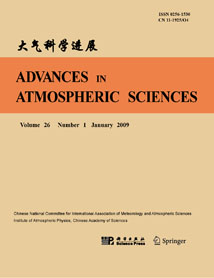| [1] |
XU Xingkui, Jason K. LEVY,
2011: The Impact of Agricultural Practices in China on Land-Atmosphere Interactions, ADVANCES IN ATMOSPHERIC SCIENCES, 28, 821-831.
doi: 10.1007/s00376-010-0007-2
|
| [2] |
LI Xiaofan, SHEN Xinyong, LIU Jia,
2014: Effects of Doubled Carbon Dioxide on Rainfall Responses to Large-Scale Forcing: A Two-Dimensional Cloud-Resolving Modeling Study, ADVANCES IN ATMOSPHERIC SCIENCES, 31, 525-531.
doi: 10.1007/s00376-013-3030-2
|
| [3] |
LIANG Feng, TAO Shiyan, WEI Jie, BUEH Cholaw,
2011: Variation in Summer Rainfall in North China during the Period 1956--2007 and Links with Atmospheric Circulation, ADVANCES IN ATMOSPHERIC SCIENCES, 28, 363-374.
doi: 10.1007/s00376-010-9220-2
|
| [4] |
YU Yongqiang, ZHENG Weipeng, WANG Bin, LIU Hailong, LIU Jiping,
2011: Versions g1.0 and g1.1 of the LASG/IAP Flexible Global Ocean--Atmosphere--Land System Model, ADVANCES IN ATMOSPHERIC SCIENCES, 28, 99-117.
doi: 10.1007/s00376-010-9112-5
|
| [5] |
ZHU Peijun, ZHENG Yongguang, ZHANG Chunxi, TAO Zuyu,
2005: A Study of the Extratropical Transformation of Typhoon Winnie (1997), ADVANCES IN ATMOSPHERIC SCIENCES, 22, 730-740.
doi: 10.1007/BF02918716
|
| [6] |
Zhixuan WANG, Jilin SUN, Jiancheng WU, Fangyue NING, Weiqi CHEN,
2020: Attribution of Persistent Precipitation in the Yangtze–Huaihe River Basin during February 2019, ADVANCES IN ATMOSPHERIC SCIENCES, 37, 1389-1404.
doi: 10.1007/s00376-020-0107-6
|
| [7] |
Qu Shaohou,
1989: Observation Research of the Turbulent Fluxes of Momentum, Sensible Heat and Latent Heat over the West Pacific Tropical Ocean Area, ADVANCES IN ATMOSPHERIC SCIENCES, 6, 254-264.
doi: 10.1007/BF02658021
|
| [8] |
Li Chongyin, Han-Ru Cho, Jough-Tai Wang,
2002: CISK Kelvin Wave with Evaporation-Wind Feedback and Air-Sea Interaction A Further Study of Tropical Intraseasonal Oscillation Mechanism, ADVANCES IN ATMOSPHERIC SCIENCES, 19, 379-390.
doi: 10.1007/s00376-002-0073-1
|
| [9] |
Ye Zhuojia, Jia Xinyuan,
1991: The Impact of Soil Moisture Availability upon the Partition of Net Radiation into Sensible and Latent Heat Fluxes, ADVANCES IN ATMOSPHERIC SCIENCES, 8, 339-350.
doi: 10.1007/BF02919616
|
| [10] |
Long Baosen,
1989: The Latent and Sensible Heat Fluxes over the Western Tropical Pacific and Its Relationship to ENSO, ADVANCES IN ATMOSPHERIC SCIENCES, 6, 467-474.
doi: 10.1007/BF02659080
|
| [11] |
Fu Congbin, Henry Diaz, Fan Huijun,
1992: Variability in Latent Heat Flux over the Tropical Pacific in Association with Recent Two ENSO Events, ADVANCES IN ATMOSPHERIC SCIENCES, 9, 351-358.
doi: 10.1007/BF02656945
|
| [12] |
Zhang Renhe, Chao Jiping,
1993: Unstable Tropical Air-Sea Interaction Waves and Their Physical Mechanisms, ADVANCES IN ATMOSPHERIC SCIENCES, 10, 61-70.
doi: 10.1007/BF02656954
|
| [13] |
PU Shuzhen, ZHAO Jinping, YU Weidong, ZHAO Yongping, YANG Bo,
2004: Progress of Large-Scale Air-Sea Interaction Studies in China, ADVANCES IN ATMOSPHERIC SCIENCES, 21, 383-398.
doi: 10.1007/BF02915566
|
| [14] |
GAO Rong, WEI Zhigang, DONG Wenjie, ZHONG Hailing,
2005: Impact of the Anomalous Thawing in the Tibetan Plateau on Summer Precipitation in China and Its Mechanism, ADVANCES IN ATMOSPHERIC SCIENCES, 22, 238-245.
doi: 10.1007/BF02918513
|
| [15] |
Anmin DUAN, Ruizao SUN, Jinhai HE,
2017: Impact of Surface Sensible Heating over the Tibetan Plateau on the Western Pacific Subtropical High: A Land-Air-Sea Interaction Perspective, ADVANCES IN ATMOSPHERIC SCIENCES, 34, 157-168.
doi: 10.1007/s00376-016-6008-z
|
| [16] |
Marco Y.-T. LEUNG, Dongxiao WANG, Wen ZHOU, Yuntao JIAN,
2023: Extended Impact of Cold Air Invasions in East Asia in Response to a Warm South China Sea and Philippine Sea, ADVANCES IN ATMOSPHERIC SCIENCES, 40, 531-540.
doi: 10.1007/s00376-022-2096-0
|
| [17] |
Ying NA, Riyu LU, Bing LU, Min CHEN, Shiguang MIAO,
2019: Impact of the Horizontal Heat Flux in the Mixed Layer on an Extreme Heat Event in North China: A Case Study, ADVANCES IN ATMOSPHERIC SCIENCES, 36, 133-142.
doi: 10.1007/s00376-018-8133-3
|
| [18] |
LIU Bin, GUAN Changlong, Li'an XIE, ZHAO Dongliang,
2012: An Investigation of the Effects of Wave State and Sea Spray on an Idealized Typhoon Using an Air--Sea Coupled Modeling System, ADVANCES IN ATMOSPHERIC SCIENCES, 29, 391-406.
doi: 10.1007/s00376-011-1059-7
|
| [19] |
CHEN Jiepeng, WU Renguang, WEN Zhiping,
2012: Contribution of South China Sea Tropical Cyclones to an Increase in Southern China Summer Rainfall Around 1993, ADVANCES IN ATMOSPHERIC SCIENCES, 29, 585-598.
doi: 10.1007/s00376-011-1181-6
|
| [20] |
CHEN Wen, ZHU Deqin, LIU Huizhi, SUN Shufen,
2009: Land-Air Interaction over Arid/Semi-arid Areas in China and Its Impact on the East Asian Summer Monsoon. Part I: Calibration of the Land Surface Model (BATS) Using Multicriteria Methods, ADVANCES IN ATMOSPHERIC SCIENCES, 26, 1088-1098.
doi: 10.1007/s00376-009-8187-3
|















 AAS Website
AAS Website 
 AAS WeChat
AAS WeChat 
 DownLoad:
DownLoad: